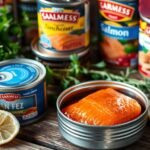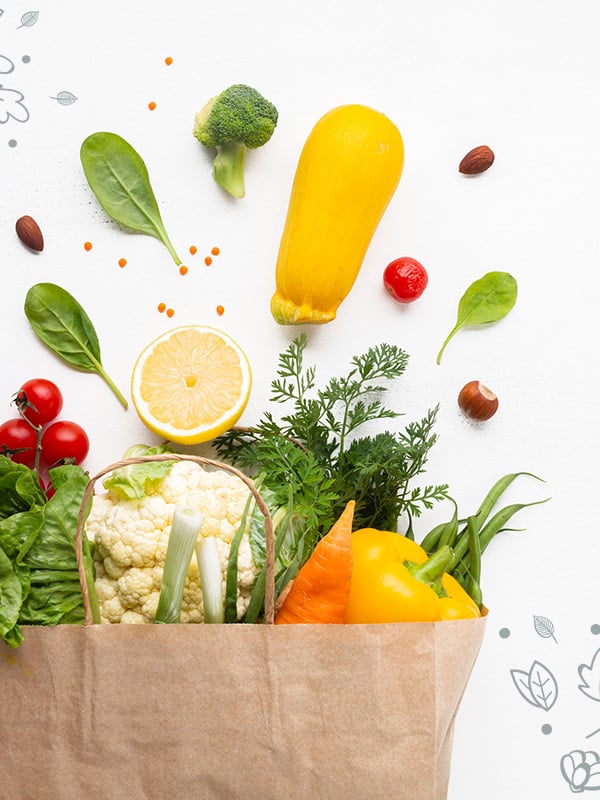Canned salmon recipes offer a variety of tasty and nutritious meals. They are perfect for those looking for healthy meal ideas. Canned salmon is packed with protein and omega-3 fatty acids. It’s also great for busy people because it’s easy to prepare and lasts a long time.
Table of Contents
Canned salmon dishes are not only good for you but also versatile. You can use it in salads, sandwiches, and more. Exploring different recipes can help you find your favorite healthy meals. Canned salmon is ideal for quick lunches or nutritious dinners.
Introduction to Canned Salmon
Canned salmon is a nutritious and convenient ingredient. It’s great for making healthy meals like salads and sandwiches. With canned salmon, you get the benefits of omega-3 fatty acids and protein in a budget-friendly and easy way.
Key Takeaways
- Canned salmon is a nutritious and versatile ingredient
- Canned salmon recipes are perfect for healthy meal ideas
- Canned salmon is a great source of protein and omega-3 fatty acids
- Canned salmon has a long shelf life and is easy to prepare
- Canned salmon dishes can be used in a variety of meals, from salads to sandwiches
- Canned salmon is a convenient and affordable way to enjoy healthy meal ideas
Understanding Different Types of Canned Salmon
There are many types of canned salmon, each with its own benefits. Knowing the differences helps you pick the right salmon nutrition for your diet.
Wild-caught salmon has more omega-3s and fewer contaminants than farm-raised. Different salmon species, like pink, sockeye, and red, offer unique tastes and nutrients.
Wild-Caught vs. Farm-Raised Options
Wild-caught salmon is healthier because it’s full of omega-3s and has fewer pollutants. Farm-raised salmon, however, might have more saturated fats and less protein.
Pink vs. Sockeye vs. Red Salmon
Pink salmon tastes milder and has less fat than sockeye and red. Sockeye, or red salmon, is richer in flavor and fat, making it a favorite for types of canned salmon.
Bone-In vs. Boneless Varieties
Choosing between bone-in and boneless canned salmon is important. Bone-in salmon is cheaper and has more calcium. Boneless salmon is easier to eat and tastes milder.
By knowing the differences, you can pick the salmon nutrition that suits your diet best.
Essential Benefits of Including Canned Salmon in Your Diet
Exploring canned salmon reveals many salmon benefits. It’s packed with protein, omega-3s, and vitamins. This makes it a great choice for healthy meal ideas.
Canned salmon is full of protein, perfect for those wanting more. It also has omega-3s for heart health. Plus, it’s got vitamins D, selenium, and B12 for overall health.
- Reduced risk of heart disease due to omega-3 fatty acids
- Improved brain function and cognitive development
- Support for joint health and reduced inflammation
Adding canned salmon to your diet brings these benefits. It’s a convenient and nutritious healthy meal idea. It’s great for boosting protein or adding variety to meals.
Canned salmon is versatile for many dishes, like salads, sandwiches, pasta, and stir-fries. Its health perks and ease make it a favorite among health-focused people.
How to Cook Canned Salmon: Basic Techniques
Cooking canned salmon is easy and can make your meals tasty. It’s great for salads, sandwiches, and more. First, drain and clean the salmon, removing bones and skin. This makes the salmon smooth and flavorful.
For cooking, try baking or grilling. These methods cook the salmon fast and add flavor. Use lemon juice and herbs for extra taste. These steps help you make a healthy, tasty meal with canned salmon.
Draining and Cleaning Methods
To drain and clean the salmon, open the can and pour out the liquid. Use a fork to remove bones and skin. Rinsing under cold water helps remove salt and impurities.
Basic Seasoning Approaches
After cleaning, add flavor with simple seasonings. Lemon juice, salt, and pepper give a tangy taste. Herbs like dill or parsley add freshness. These seasonings make your meal delicious and healthy.
Learning these basic techniques lets you make many tasty dishes with canned salmon. It’s perfect for quick lunches or healthy dinners. With these methods, you can enjoy a meal that’s both nutritious and flavorful.
Quick and Easy Canned Salmon Recipes
Canned salmon is a smart choice for meal planning. It’s versatile and easy to use. You can make many tasty dishes with it, like salads and sandwiches. Plus, you can cook a meal in under 30 minutes, which is great for those with busy schedules.
Some favorite recipes include a salmon salad with greens, cherry tomatoes, and lemon dressing. Or, try a salmon sandwich with lettuce, tomato, and mayo on whole-grain bread. You can also add it to pasta, stir-fries, or omelets for a protein-rich meal. The secret to great meals with canned salmon is to keep it simple and try new flavors.
- Serve canned salmon on top of a bed of mixed greens with your favorite toppings
- Mix canned salmon with diced onions, mayonnaise, and chopped hard-boiled eggs for a tasty salad
- Use canned salmon as a topping for crackers or toast points for a quick snack
Adding canned salmon to your meals means you get a healthy, easy option. It’s full of protein and omega-3s. With a bit of creativity, you can make many delicious dishes with canned salmon.
Kitchen Tools Needed for Preparing Canned Salmon
To make tasty canned salmon dishes, you need the right tools. A well-stocked kitchen is key. You’ll need a can opener, cutting board, and cooking utensils.
Having the right tools is crucial for cooking techniques. They help you grill, sauté, or bake. With the right tools, you can unlock many cooking methods.
Essential Equipment List
- Can opener
- Cutting board
- Cooking utensils (e.g., spatula, fork, knife)
- Cooking pot or pan
Optional Gadgets for Advanced Preparation
- Food processor for chopping or pureeing ingredients
- Grill pan for adding a smoky flavor
- Immersion blender for soups or sauces
With these tools, you can try many cooking techniques. You can make a variety of tasty canned salmon dishes. Choose the right tools for your needs and use them safely.
Creating Healthy Salmon Salads and Sandwiches
Salmon salads are a great choice for healthy meals. You can mix canned salmon with fresh veggies like onions, carrots, and celery. Try a simple salad with canned salmon, mixed greens, cherry tomatoes, and a citrus dressing for a quick meal.
For a salad with more protein, add canned salmon to quinoa with roasted broccoli and Brussels sprouts. Adding avocado or nuts boosts the salad’s nutrition. Use Greek yogurt or hummus instead of mayo for a creamy base.

Salmon sandwiches are also a healthy option. Use whole-grain bread, lettuce, and tomato. Adding cheese or eggs increases the protein. Try different breads like bagels or ciabatta and add cucumbers or bell peppers for extra flavor.
Here are some tips for healthy salmon salads and sandwiches:
- Use fresh and sustainable ingredients whenever possible
- Choose whole-grain bread for your sandwiches
- Add a variety of colorful vegetables to your salads
- Experiment with different seasonings and spices to add flavor
Warm Canned Salmon Dish Ideas
There are many ways to cook with canned salmon, making tasty warm dishes. You can whip up soups, casseroles, or pasta dishes. Try a salmon pasta bake by mixing canned salmon with pasta, cheese, and sauce. Then, bake it until it’s golden.
For a quick stir-fry, cook canned salmon with veggies like bell peppers and carrots. Use sautéing or steaming to cook. Serve it over rice or noodles for a fast meal. Or, make a salmon and potato casserole by layering salmon, potatoes, and cheese in a dish. Bake until it’s hot and bubbly.
- Salmon and spinach quiche
- Salmon and mushroom risotto
- Salmon and vegetable soup
These are just a few ideas for using canned salmon in warm dishes. Try different ingredients and recipes to find your favorites. Get creative and enjoy experimenting with canned salmon.
Storage Tips and Safety Guidelines
Storing canned salmon right is key to keeping it fresh and safe. Follow simple tips and guidelines to ensure your canned salmon stays good. It’s important to handle and store it safely to avoid contamination and illness.
Keep your canned salmon in a cool, dry spot. Look for signs of spoilage like dents, rust, or swelling. Always check the expiration date before eating it. These steps help keep your canned salmon fresh and safe.
Proper Storage Methods
- Store canned salmon in a cool, dry place, away from direct sunlight.
- Keep canned salmon away from heat sources, such as ovens or radiators.
- Check cans regularly for signs of spoilage or damage.
Signs of Spoilage
Look for signs of spoilage in your canned salmon. These include an off smell, slimy texture, or mold. If you see any, throw the can away right away. Food safety is crucial when handling canned salmon.
Food Safety Best Practices
Always handle canned salmon safely to prevent contamination. Wash your hands before and after touching it. Clean and sanitize any tools or surfaces that come into contact with it. By following these steps, you can enjoy your canned salmon safely and healthily.
Nutritional Profile of Canned Salmon
Canned salmon is packed with nutrients like vitamins, minerals, and proteins. It’s a great source of omega-3 fatty acids. These are good for your heart and brain. They also help reduce inflammation and boost your overall health.
Adding canned salmon to your meals can be very beneficial. It’s high in protein and vitamins and minerals. These include vitamin D, selenium, and B vitamins. They help your immune system, energy levels, and overall health.

- High-quality protein for muscle growth and repair
- Omega-3 fatty acids for heart and brain health
- Vitamins and minerals like vitamin D, selenium, and B vitamins
By eating canned salmon, you get the benefits of salmon nutrition. It’s perfect for improving heart health, supporting your immune system, or adding variety to your meals. Canned salmon is a great choice.
Budget-Friendly Meal Planning with Canned Salmon
Looking for affordable and healthy meals can be tough. Canned salmon is a great choice because it’s cheaper than fresh salmon. It’s perfect for making tasty, budget-friendly meals.
Canned salmon is much cheaper than fresh salmon. It can be up to 50% less expensive. Plus, it lasts longer, which means less waste and more savings.
Cost Comparison with Fresh Salmon
Canned salmon is way more affordable than fresh salmon. A 5-ounce can costs about $2. But a 5-ounce serving of fresh salmon can cost over $10.
Bulk Buying Tips
Buying canned salmon in bulk can save you even more money. It’s cheaper per can when you buy more. Here are some tips:
- Purchasing canned salmon in 12-packs or 24-packs
- Buying canned salmon in bulk from wholesale clubs or online retailers
- Shopping during sales or using coupons to reduce the cost per can
Weekly Meal Prep Ideas
With canned salmon, you can make many budget-friendly meals. Here are some ideas:
- Salmon salads with mixed greens and vegetables
- Salmon sandwiches with whole grain bread and avocado
- Salmon stir-fries with brown rice and frozen vegetables
Adding canned salmon to your meal planning is smart. It’s affordable and versatile. It’s a great choice for budget-friendly meals.
| Meal Idea | Cost | Servings |
|---|---|---|
| Salmon Salad | $3.50 | 4 |
| Salmon Sandwich | $2.75 | 4 |
| Salmon Stir-Fry | $4.25 | 4 |
Common Mistakes to Avoid When Preparing Canned Salmon
When you’re cooking with canned salmon, it’s key to know the common mistakes that can mess up your dish. One big thing to get right is not overcooking or underseasoning your salmon.
To steer clear of these errors, here are some tips:
- Always check the expiration date of your canned salmon to ensure freshness.
- Drain and rinse the salmon thoroughly before cooking to remove excess salt and liquids.
- Use a variety of herbs and spices to add flavor to your dish, rather than relying on salt and pepper alone.
By keeping these common mistakes in mind and using the right cooking techniques, you can make tasty and healthy canned salmon dishes. They’re sure to wow your guests.
| Mistake | Correction |
|---|---|
| Overcooking | Cook for the recommended time, and check for doneness. |
| Underseasoning | Use a variety of herbs and spices to add flavor. |
| Using low-quality ingredients | Choose fresh and high-quality ingredients for the best results. |
Conclusion: Making the Most of Your Canned Salmon Meals
Canned salmon is a great addition to your meals. It’s full of nutrients and can be used in many ways. You can make healthy salads, tasty sandwiches, and warm dishes with it.
Adding canned salmon to your meals is easy and saves time. It’s perfect for those who want to eat well without the fuss of fresh fish. It’s also a good way to save money and add more healthy meal ideas to your diet.
With a bit of creativity, canned salmon can become many delicious meals. So, use this convenient and nutritious ingredient to make your meals better. Start enjoying your canned salmon recipes today.
FAQ
What are the different types of canned salmon available?
You can find several types of canned salmon. These include wild-caught and farm-raised options. There are also different species like pink, sockeye, and red salmon. Each type has its own taste and nutritional value.
What are the health benefits of including canned salmon in my diet?
Canned salmon is packed with protein, omega-3 fatty acids, and vitamins and minerals. Adding it to your meals can boost your nutrition. It’s great for your health and well-being.
How do I properly prepare and cook canned salmon?
Start by draining and cleaning the salmon. Remove bones and skin, then season it. You can bake, grill, or sauté it. These methods make for tasty and healthy dishes.
What are some quick and easy canned salmon recipe ideas?
Canned salmon is versatile and can be used in many dishes. Try it in salads, sandwiches, soups, or casseroles. There are many quick and easy recipes to make healthy meals.
How should I store canned salmon to ensure its safety and quality?
Store canned salmon in a cool, dry place. Check for signs of spoilage before eating. Following food safety tips is key to keeping it fresh and safe.
What is the nutritional profile of canned salmon?
Canned salmon is rich in protein, omega-3 fatty acids, and vitamins like B12 and D. It also has selenium. The exact nutrients vary by type and brand, but it’s always a healthy choice.
How can I incorporate canned salmon into my budget-friendly meal planning?
Canned salmon is cheaper than fresh salmon, making it perfect for saving money. Buy it in bulk and use it in meal prep. This way, you can enjoy healthy meals without spending a lot.
What are some common mistakes to avoid when preparing canned salmon?
Avoid overcooking, underseasoning, and using low-quality ingredients. Focus on proper preparation and seasoning. This ensures your dishes are both delicious and healthy.



